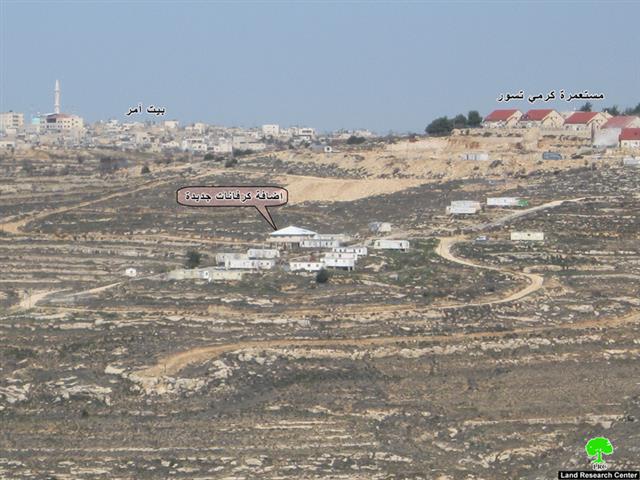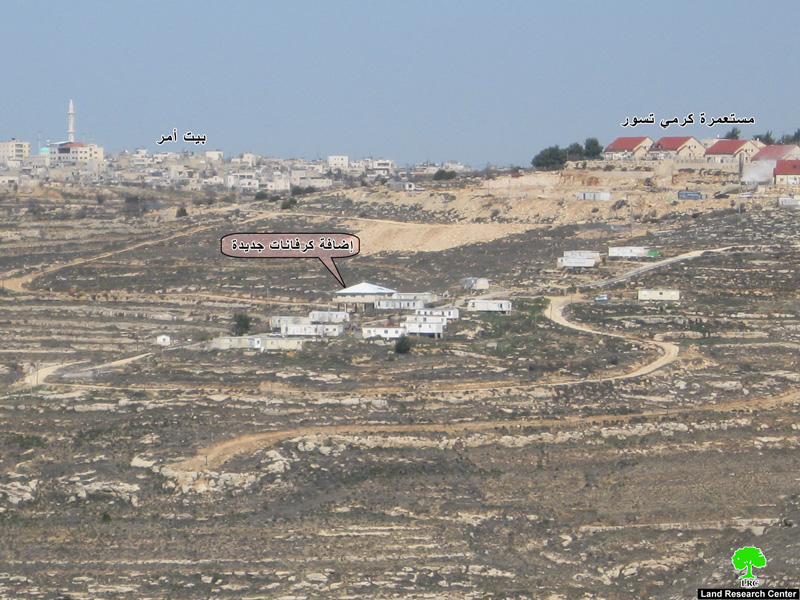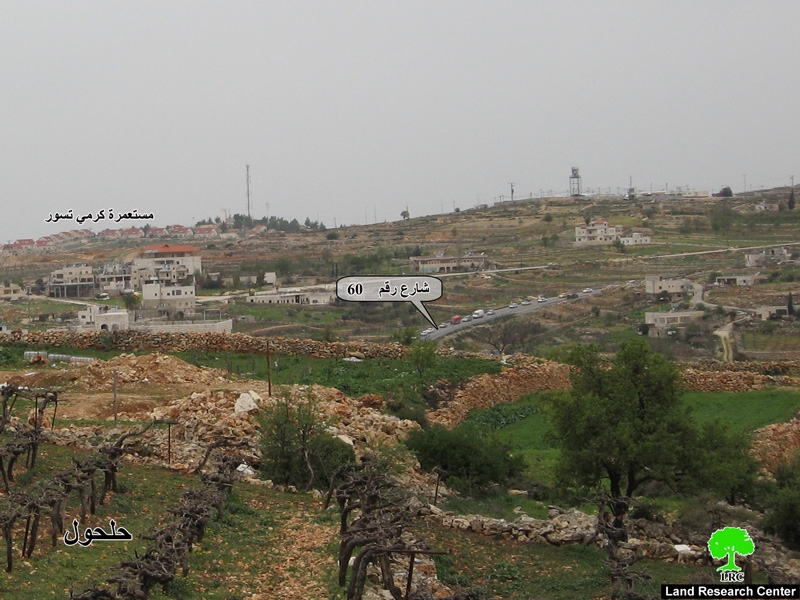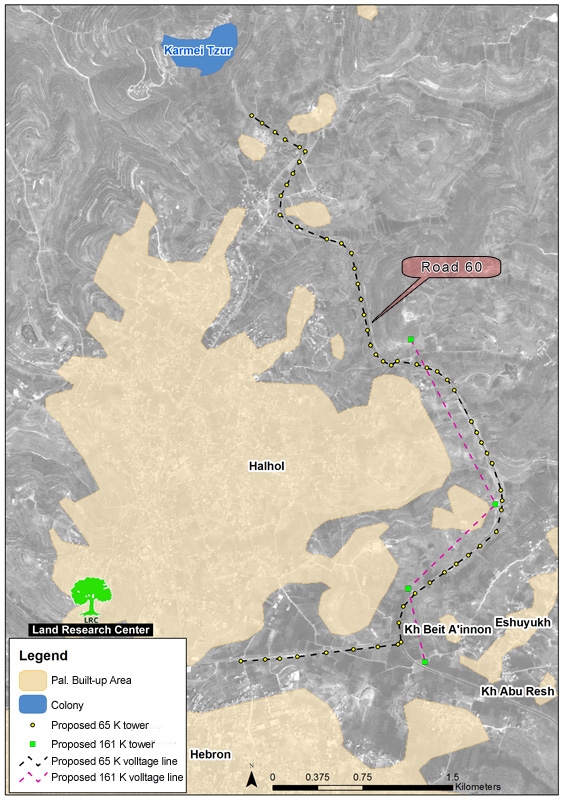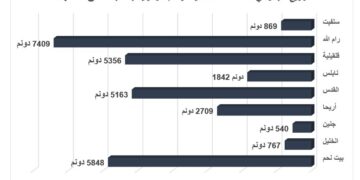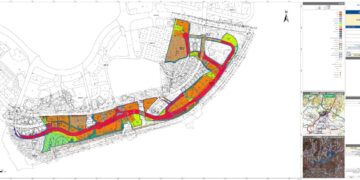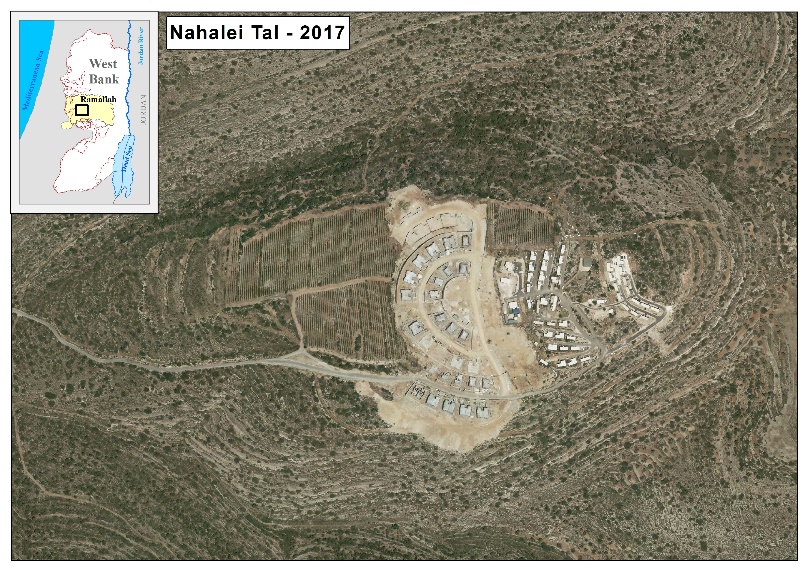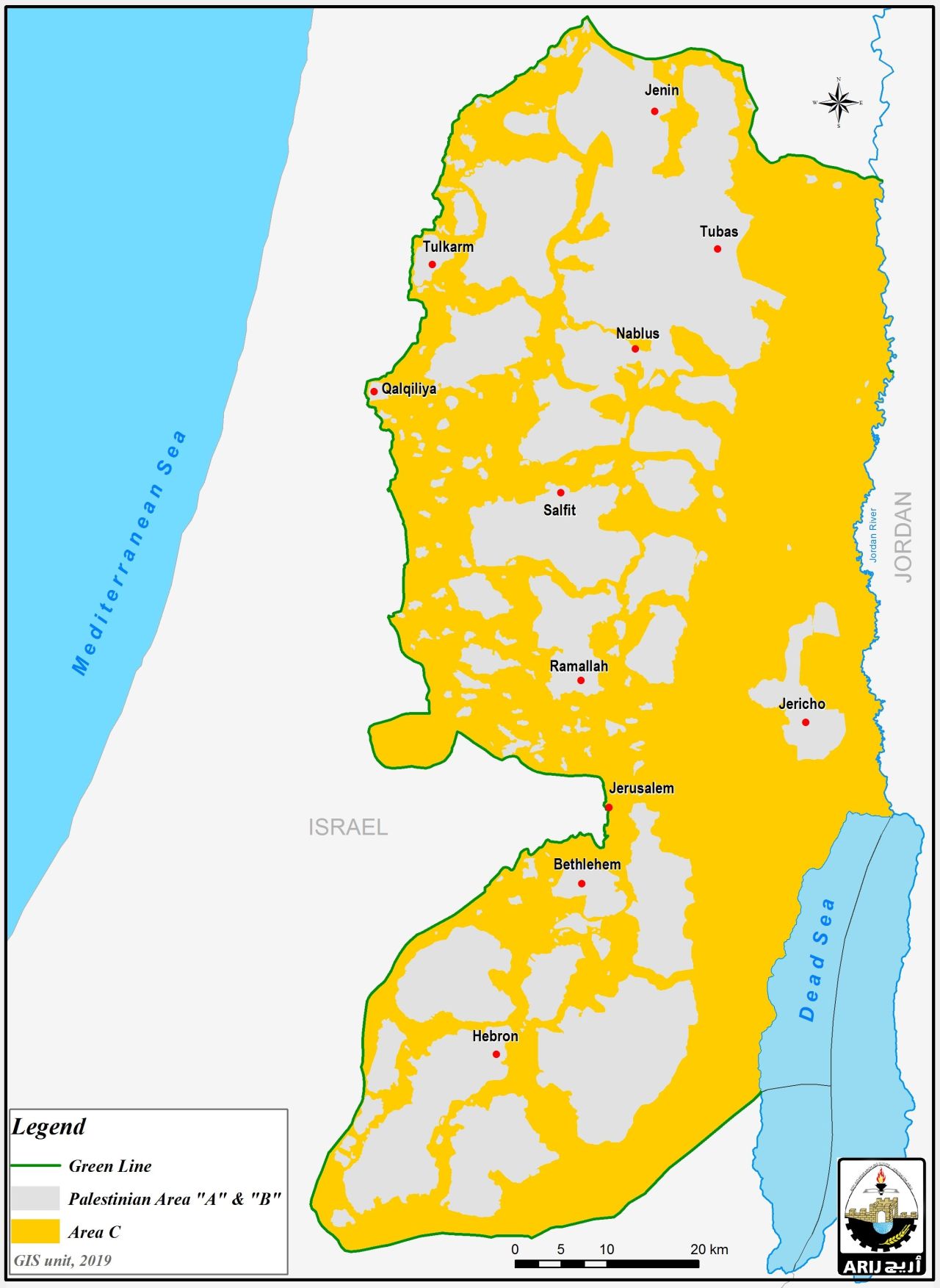Karmei Tzur Settlement:
The settlement of Karmi Tzur was established in year 1984 to the north of Hebron city, on lands originally owned by residents of Halhul and Beit Ummer towns. Today, the settlement occupies a total land area of 327 dunums, where the built-up area constitutes almost half of the settlement's area and houses a total of 713 Israeli settlers.
Settlement Expansion:
While the Israeli Prime Minister, Ehud Olmert, is talking about his intention of dismantling colonial outposts, Israeli Authorities embarked on January 26th, 2008 on constructing 5 additional new caravans on a 3-dunums piece of land owned by Abu Yousef and Abu Dayyah families. The targeted lands are located in Shi’eb Abu Yousif site in the town of Halhul.
The caravans have been added to a colonial outpost (established in 2001) located west of the settlement of Karmi Tzur. About 4 dunums have been razed in preparation for the new caravans while a road linking the caravans with the outpost have been prepared earlier.
Photo 1. The placement of additional caravans to the settlement of
Karmi Tzur on Halhul Lands
Violations Carried Out by Karmi Tzur settlers against Palestinian Lands and Farmers:
Since the establishment of Karmei Tzur settlements, its settlers have carried out a series of attacks against Palestinians and their lands.
-
In 1984, Israeli settlers attacked Mr. Rajab Misleh Awwad Abu Yousef while he was working in his land. He was thrown out of by Karmi Tzur settlers and prevented from reaching his land. Such an incident was carried out in the presence of Israeli Occupation soldiers.
-
A military order was issued in 1984 which stated the confiscation of 25 dunums of lands for military uses, to construct a fence around the settlement. The targeted lands were on the expanse of Halhul town.
-
In 1998 Israeli Occupation Authorities removed the old fence surrounding the settlement and replaced it with a new one for the purpose of enlarging the settlement's area. About 15 dunums were isolated (and later confiscated) behind the new fence. Lands belonged to families of Madia and Abu Dayya in Halhul town.
-
In 2001 Israeli settlers intensified their colonial activities as they relocated the caravans 25 dunums away from the original settlement location. Caravans were relocated on lands of Shi’eb Al Hajj and Shi’eb Abu Yousif in Halhul towns and on parts of Beit Ummar town. A colonial road was also established to link the newly-placed caravans with the main settlement while electrical poles were constructed to provide the caravans with electricity.
-
At the inception of second intifada in September 2000, Palestinian land owners were prevented from reaching their lands in the vicinity of the settlement. Karmi Tzur settlers took advantage of such a prohibition and poisoned the vine yards surrounding the settlement. The “prohibited zone” totals about 15 dunums and belongs to Al Madia family. The prohibition was instituted due to the close proximity of the land to the colonial road.
-
In March 2003 Karmi Tzur settlers planted trees and placed water dripping pipes on Palestinian lands surrounding the settlement. Upon discovering this incident, Palestinian land owners removed the pipes and the plants. In retaliation, Israeli settlers spread large quantities of poison in the vine yards and completely destroyed them. Palestinian land owners brought an agricultural expert to investigate the reasons behind the paralysis of their fields who, in turn, confirmed that the fields were targeted by poisoning.
-
In 2006 Israeli occupation forces placed a new barbed wires fence leading to the isolation of 20 dunums of lands under the pretext of providing security for Israeli settlers. The isolated lands belong to Abdullah Abu Dayya, Mahmoud Mustafa Abu Dayya, Khalil Mohammad Abed Rabbo Abu Dayya, the heirs of Hajj Hijazi Madia, Mohammad Abdel Aziz Madia, Yaqoub Saber Al Barbarawi, Bader Mohammad Issa Abu Yousef, Hamdi Abu Yousef and well as Abdullah Aqel and his brothers.
Photo 2: Israeli occupation soldiers prevent Palestinians from plowing their lands.
The Land Research Center interviewed a farmer from Madia family who witnessed the series of violations carried out by Karmi Tzur settlers since 1984. Mr. Madia indicated the following: We are continuously subjected to settlers’ attacks that are carried out with complete coordination with Israeli occupation forces guarding the settlement. We have coordinated on numerous occasions with the Palestinian DCL to reach our lands, yet to no avail. In December 2007, we (the owners of grave fields surrounding the settlement of Karmi Tzur) presented a complaint to the Israeli official responsible for the lands surrounding the settlement. The complaint described the damaged grape fields due to the military injunctions that are preventing us from reaching our lands (except on few occasions) only to provide “security for the settlers.” We have demanded to be allowed to bring in with us heavy machinery (tractors and the like) into the land as to plant it anew and make the necessary modifications/renovations it needs. We have argued that the land has become useless due to the Israeli restrictions. The Israeli official promised to invite the Palestinian farmers to the affected locations as to specify the lands to which access can be granted. We are still waiting and we will keep submitting complaints on the basis that it is a mean to start a campaign to save the land from further colonial expansion.
The memory of Mr. Madia is filled with painful events that cannot be wiped away as time passes by. He continued his testimony saying: 'In April 2005 a friend of mine and me went to our lands to plow it. However, a group of settlers came to us and ordered us to vacate the land. We refused and continued our work while the settlers stayed beside us. I then asked one of the settlers: “when will we live in peace?” He addressed me by saying “you won’t have peace here. If you want peace, leave to Jordan.” Immediately after that conversation the settlers prevented us from continuing our work and threw us out of our land.'
General Information about the Town of Halhul:
The town of Halhul is located 7 kilometers north of Hebron city. The area of the town is 39,000 dunums, of which, 9,000 dunums constitute the built-up area. The remaining 30,000 dunums are used for agricultural purposes in which grapes, almonds and peaches are planted. The town is 1050 meters above sea level and is considered to be the highest point in Palestine. The town is a home to 22,413 residents according to the Palestinian Central Bureau of Statistics – 2007.
Photo 3: An overall view of the town of Halhul
Bypass Road 60:
Israeli Bypass Road 60 has devoured hundreds of dunums of lands owned by Palestinain families in Halhul Town including Abu Rayyan, Al Sa’ada, Al Dawada and Al Karaja. Lands located in the vicinity of the Road have also become useless due to the military prohibitions and closures leading to large losses for their owners.
Photo. 4: By-Pass Road 60 which isolated and damaged hundreds
of dunums of agricultural lands.
Photo. 5: An aerial picture marking By-Pass Road 60 leading to
the settlement of Karmi Tzur.
Checkpoints and Military Closures:
In order to “protect” Israeli settlers using the by-pass Road 60, Israeli occupation forces placed two military checkpoints in the vicinity of the town of Halhul;
-
The first one was placed at the eastern entrance of Halhul town (a.k.a. Al Nabi Younis), on Jerusalem-Hebron Road in addition to and accompanied with an iron gate and cement blocks on the Halhul-Sa’ir junction with Road 60.
-
The second checkpoint was placed at the southern entrance of the town (a.k.a. Halhul Bridge) and connects Hebron city with Bethlehem city via Halhul road. Israeli military towers are present at both checkpoints to provide protection and security for Israeli settlers using the by-pass road.
Also in 2002, Israeli occupation forces placed an earth mound at the northern entrance of Halhul town (a.k.a. Al Hawawer) which led to the deterioration of the economic and agricultural situation in the town especially for those living in the area of Al Hawawer as a large number of shops and commercial entities there went out of business.
Photo. 6: The northern entrance of the town of Halhul that is parallel to by-pass
road 60. It was totally closed off to “protect” the settlement of Karmi Tzur.
What's Next?
A time earlier to the Annapolis meeting which was held on November 26, 2008 in the United States, the Israeli Prime Minister Ehud Olmert declared that he will work to dismantle what he labeled as “outposts.” He also indicated that he will stop any colonial activities, the establishment of new settlements and the enlargement of existing ones; however, the Israeli violations taking place on daily basis proves the opposite.
Prepared by:
The Land Research Center
LRC


